Quantifying Tree Cover Loss in Urban Forests within Nairobi City Metropolitan Area from Earth Observation Data †
Abstract
:1. Introduction
2. Methods
2.1. Description of the Study Area
2.2. Data
2.3. Assessing Forest Cover Change
2.4. Trends of Change in NDVI
2.5. Land Cover Change Dynamics
2.6. The Link between Land Cover Change and Forest Cover Change Dynamics
3. Results
3.1. Urban Forest Cover Changes in Nairobi
3.2. Changes in NDVI
3.3. Land Cover Changes
3.4. Preliminary Assessment of the Potential Link between Tree Cover Loss and Human Activities
4. Discussion
4.1. The Trend of Tree Cover Loss within Urban Forests in Nairobi Metropolitan Areas
4.2. Potential Drivers of Forest Cover Change
4.3. Management of Urban Forests
4.4. Limitations of the Study and Potential Future Research Directions
5. Conclusions
Author Contributions
Institutional Review Board Statement
Informed Consent Statement
Data Availability Statement
Conflicts of Interest
References
- Tyrväinen, L.; Pauleit, S.; Seeland, K.; de Vries, S. Benefits and uses of urban forests and trees. Urban For. Trees A Ref. B 2005, 81–114. [Google Scholar] [CrossRef]
- Livesley, S.J.; Escobedo, F.J.; Morgenroth, J. The biodiversity of urban and peri-urban forests and the diverse ecosystem services they provide as socio-ecological systems. Forests 2016, 7, 291. [Google Scholar] [CrossRef]
- Borelli, S.; Conigliaro, M.; Pineda, F. Urban forests in the global context. Unasylva 2018, 69, 3–10. [Google Scholar]
- Michel, J.P. Urbanization and Ageing Health Outcomes. J. Nutr. Health Aging 2020, 24, 463–465. [Google Scholar] [CrossRef] [PubMed]
- German, L.; Jaeger, D.; Mcclain, K.M.; Nascimento, J.R.; Schoneveld, G.; Stadt, J.J. 13 Extra-Sectoral Drivers of Forest Change. Development 2005, 1, 235–246. [Google Scholar]
- Ministry of Environment and Forestry. REPUBLIC OF KENYA MINISTRY OF ENVIRONMENT AND FORESTRY Taskforce Report on Forest Resources Management and Logging Activities in Kenya. April 2018. Available online: http://www.environment.go.ke/wp-content/uploads/2018/08/Forest-Report.pdf (accessed on 21 August 2020).
- Kimutai, D.K.; Watanabe, T. Forest-cover change and participatory forest management of the lembus forest, Kenya. Environments 2016, 3, 20. [Google Scholar] [CrossRef]
- Li, X.; Chen, W.Y.; Sanesi, G.; Lafortezza, R. Remote sensing in urban forestry: Recent applications and future directions. Remote Sens. 2019, 11, 1144. [Google Scholar] [CrossRef]
- Sidhu, N.; Pebesma, E.; Câmara, G. Using Google Earth Engine to detect land cover change: Singapore as a use case. Eur. J. Remote Sens. 2018, 51, 486–500. [Google Scholar] [CrossRef]
- Hansen, M.C. High-Resolution Global Maps of 21st Century Global Forest Cover Maps. Science 2013, 342, 850–854. [Google Scholar] [CrossRef] [PubMed]
- Sexton, J.O.; Song, X.P.; Feng, M.; Noojipady, P.; Anand, A.; Huang, C.; Kim, D.H.; Collins, K.M.; Channan, S.; DiMiceli, C.; et al. Global, 30-m resolution continuous fields of tree cover: Landsat-based rescaling of MODIS vegetation continuous fields with lidar-based estimates of error. Int. J. Digit. Earth 2013, 6, 427–448. [Google Scholar] [CrossRef]
- De Schutter, A.; Kervyn, M.; Canters, F.; Bosshard-Stadlin, S.A.; Songo, M.A.M.; Mattsson, H.B. Ash fall impact on vegetation: A remote sensing approach of the Oldoinyo Lengai 2007-08 eruption. J. Appl. Volcanol. 2015, 4. [Google Scholar] [CrossRef]
- Jeyaseelan, A.T.; Roy, P.S.; Young, S.S. Persistent changes in NDVI between 1982 and 2003 over India using AVHRR GIMMS (Global Inventory Modeling and Mapping Studies) data. Int. J. Remote Sens. 2007, 28, 4927–4946. [Google Scholar] [CrossRef]
- Solomon, N.; Hishe, H.; Annang, T.; Pabi, O.; Asante, I.K.; Birhane, E. Forest cover change, key drivers and community perception in Wujig Mahgo Waren forest of northern Ethiopia. Land 2018, 7, 32. [Google Scholar] [CrossRef]
- Mongabay. Deforestation Statistics for Kenya. Deforestation Statistics of Kenya. Available online: http://rainforests.mongabay.com (accessed on 21 August 2020).
- Kenya Atlas. Nairobi and Its Environment. In A Burgeoning City; United Nations Environment Programme (UNEP): Nairobi, Kenya, 2007; Chapter 5; pp. 145–160. [Google Scholar]
- Ren, Z.; Pu, R.; Zheng, H.; Zhang, D.; He, X. Spatiotemporal analyses of urban vegetation structural attributes using multitemporal Landsat TM data and field measurements. Ann. For. Sci. 2017, 74. [Google Scholar] [CrossRef]
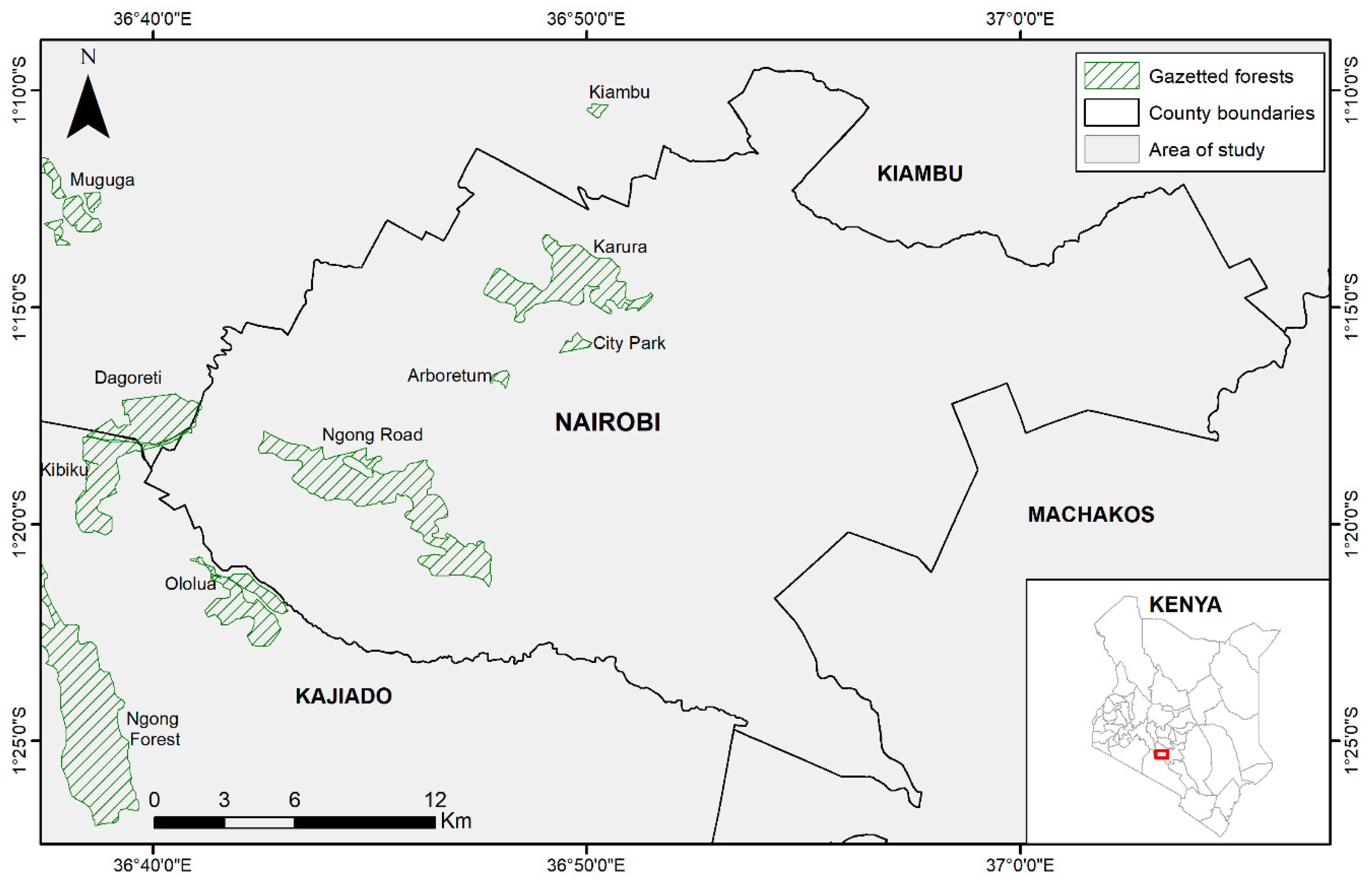
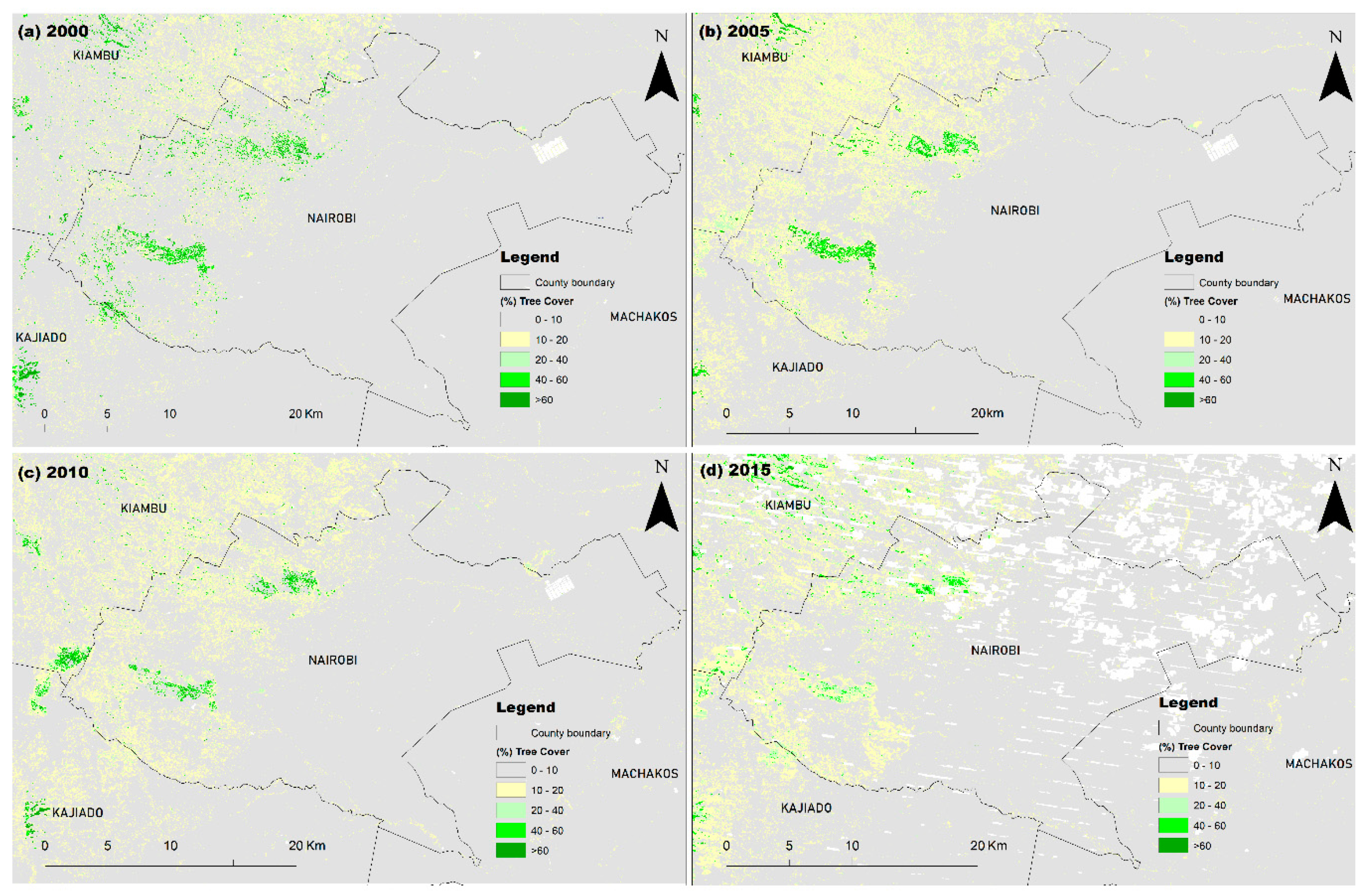
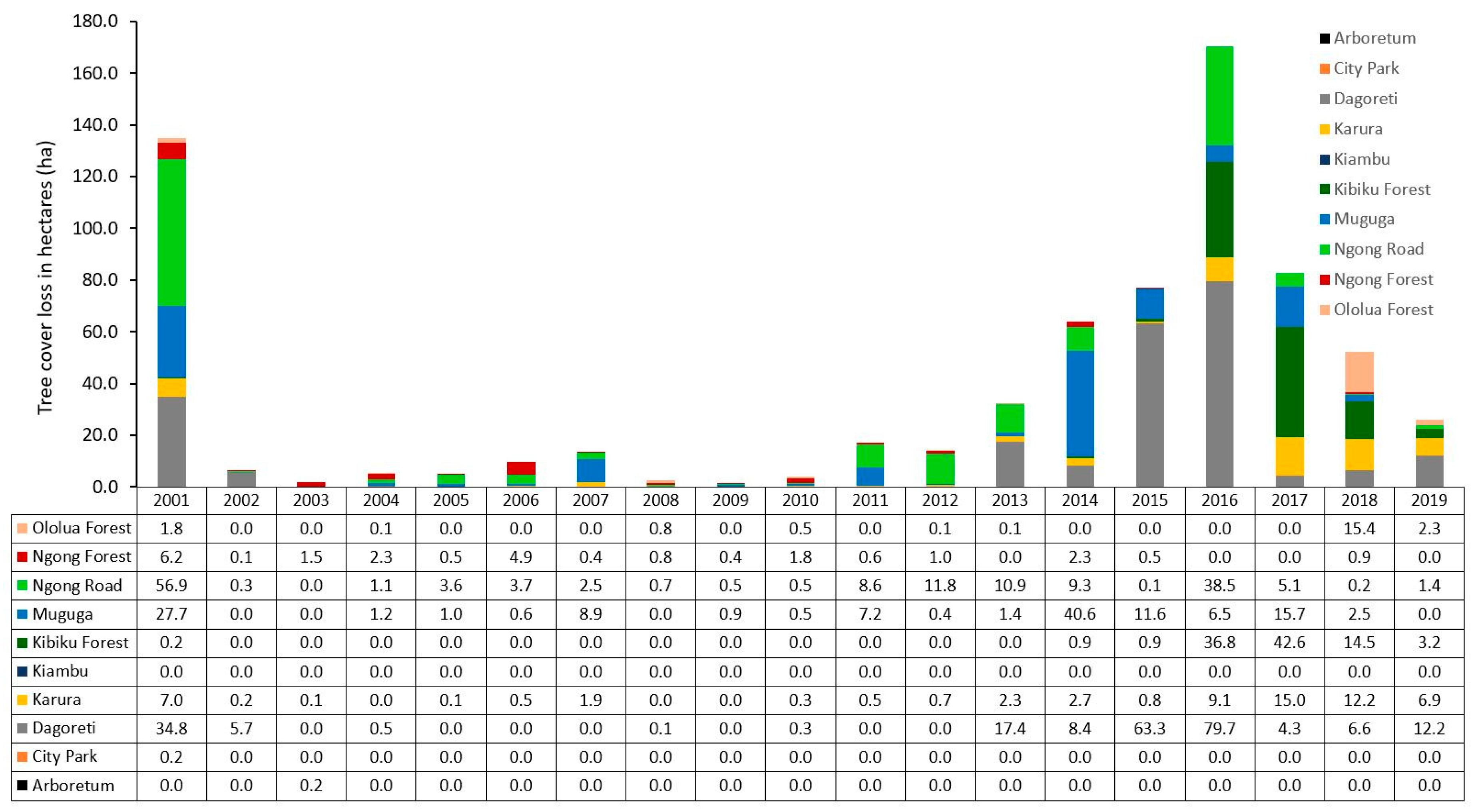
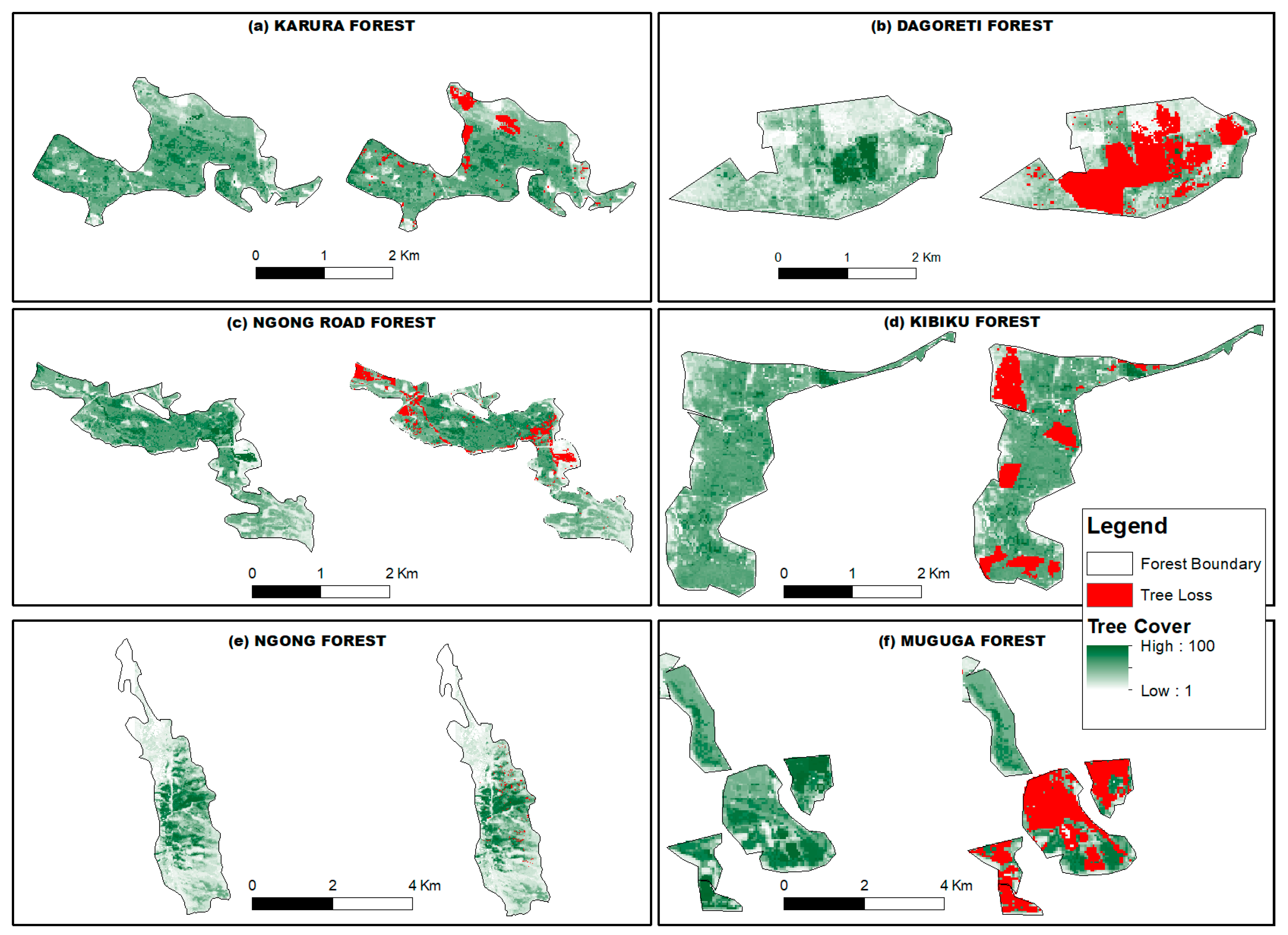

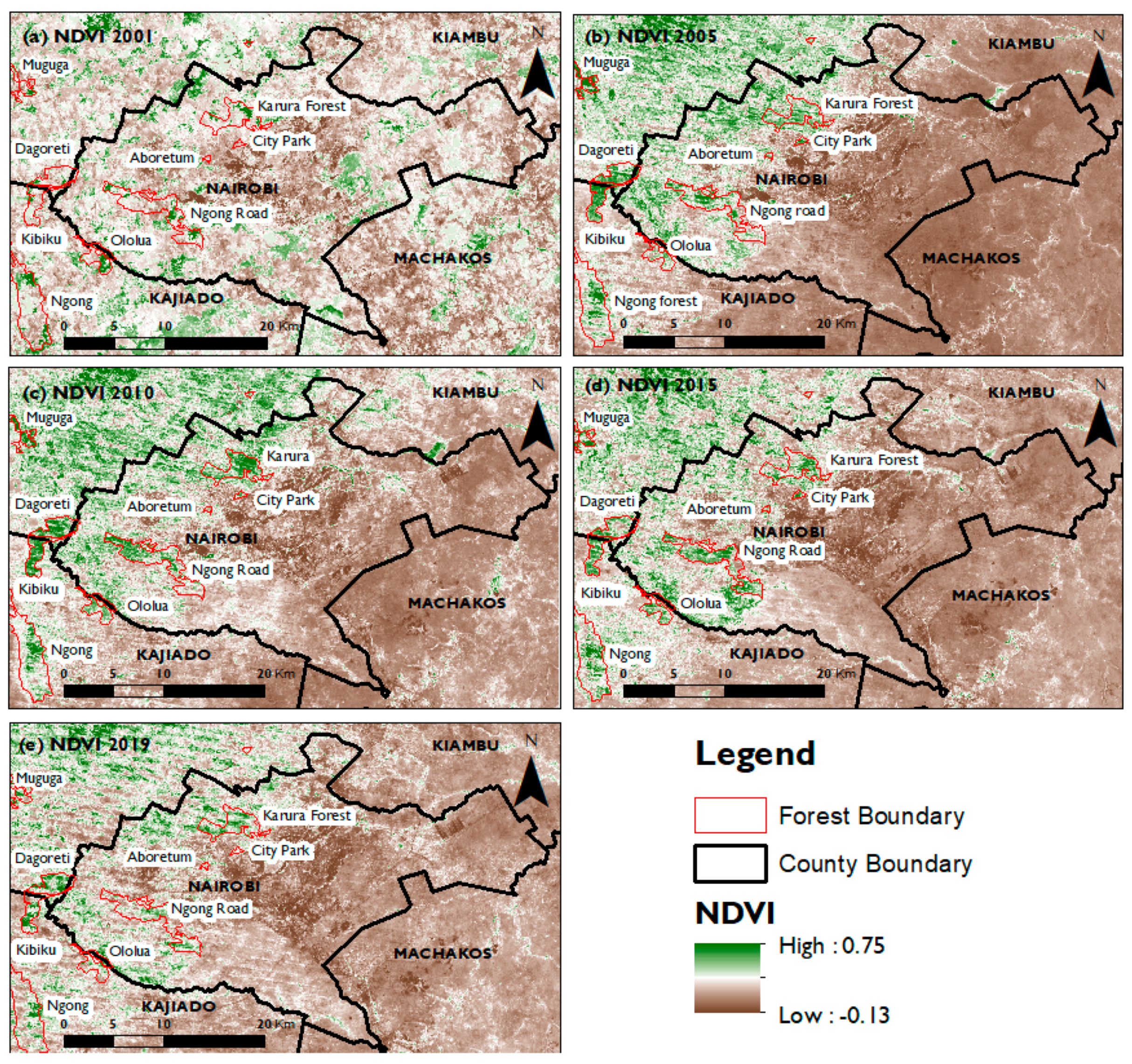
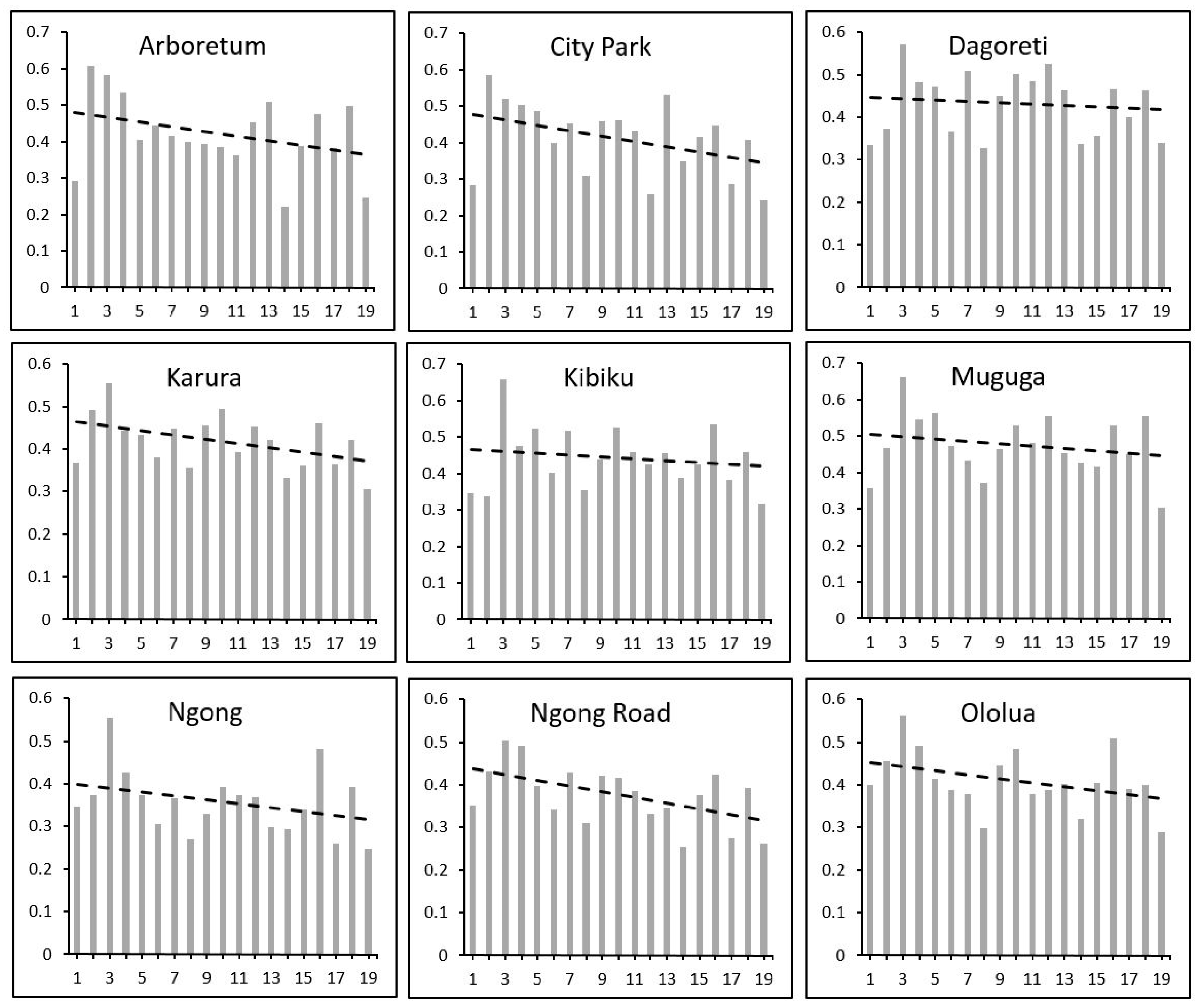
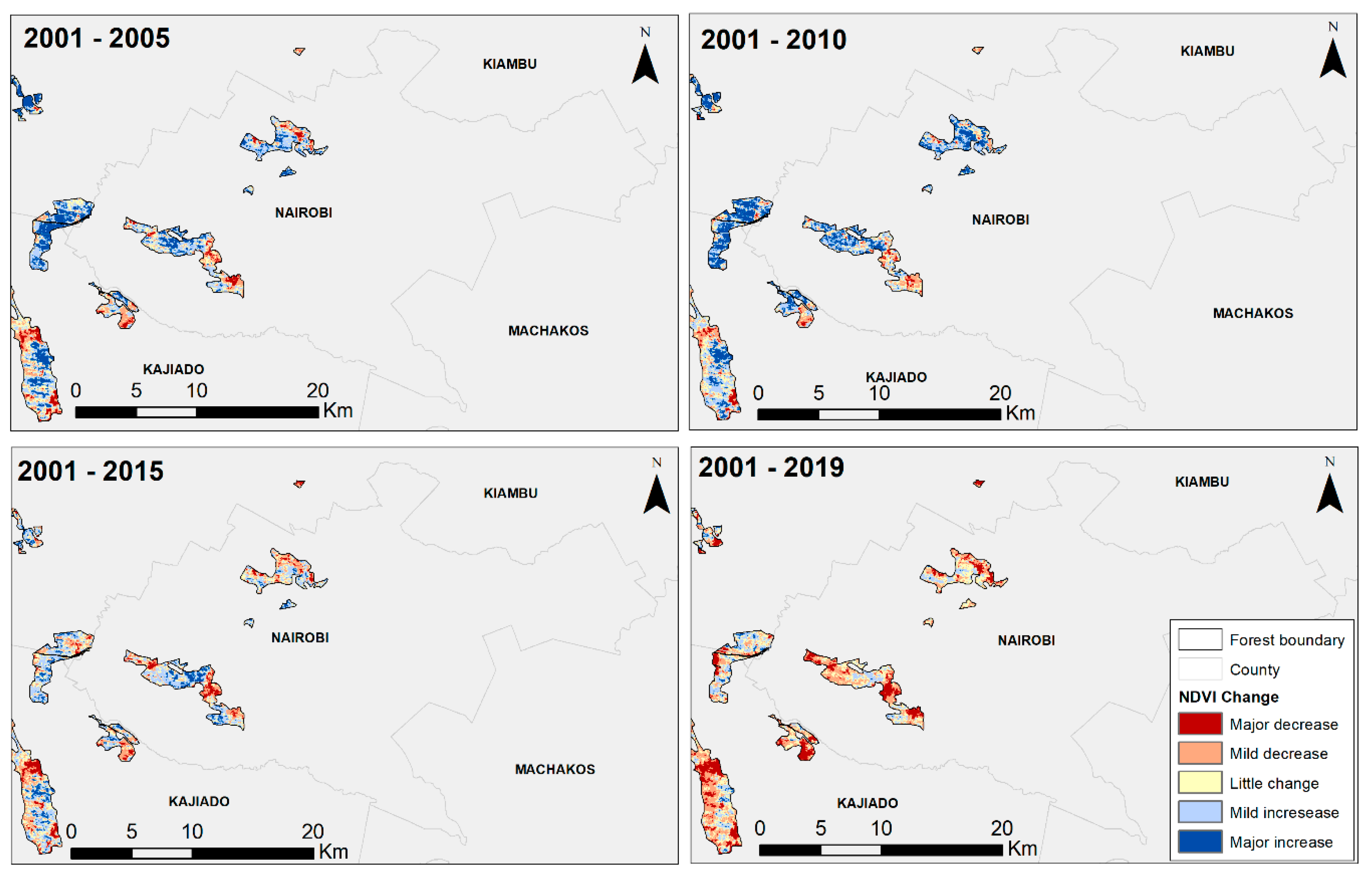
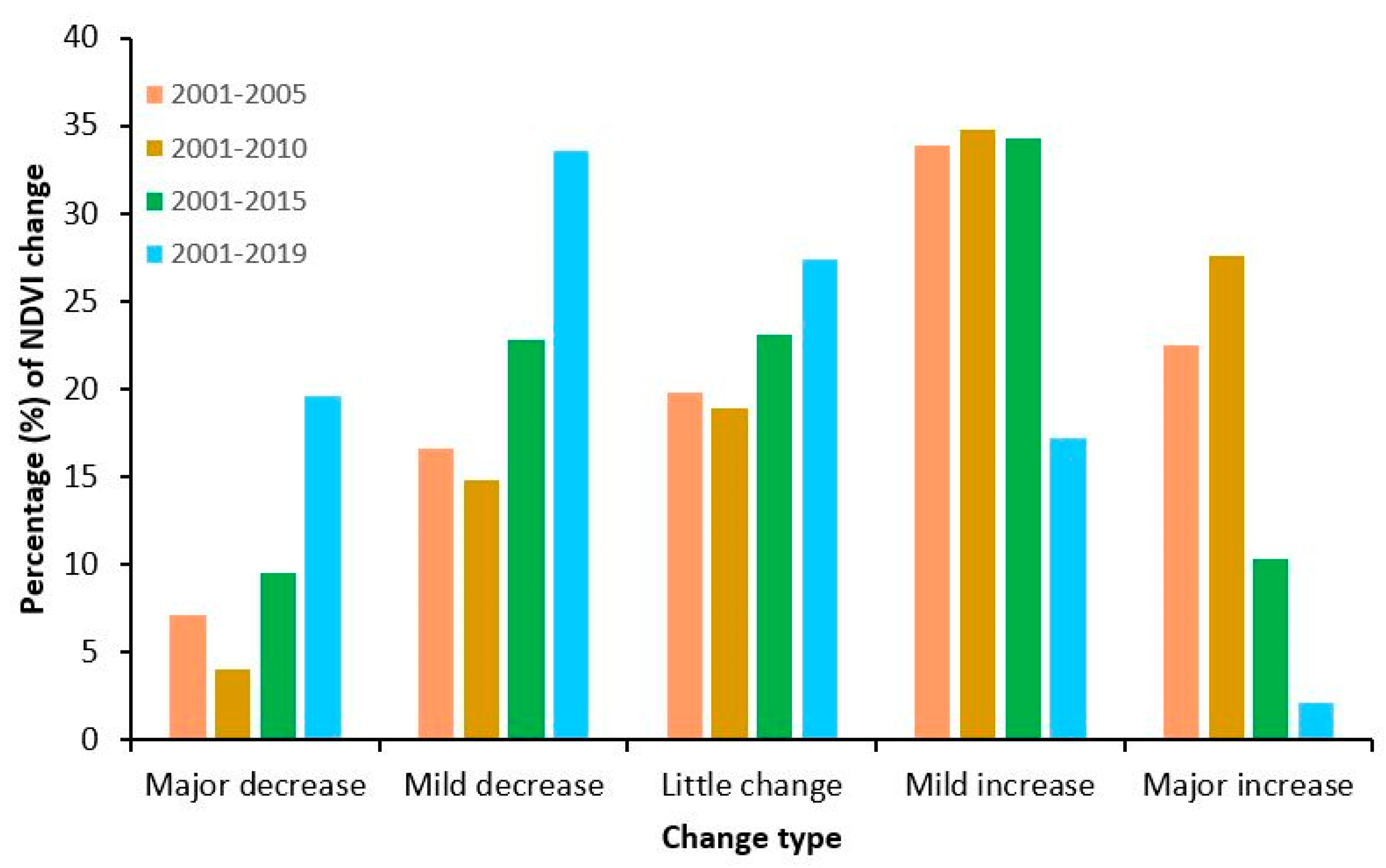
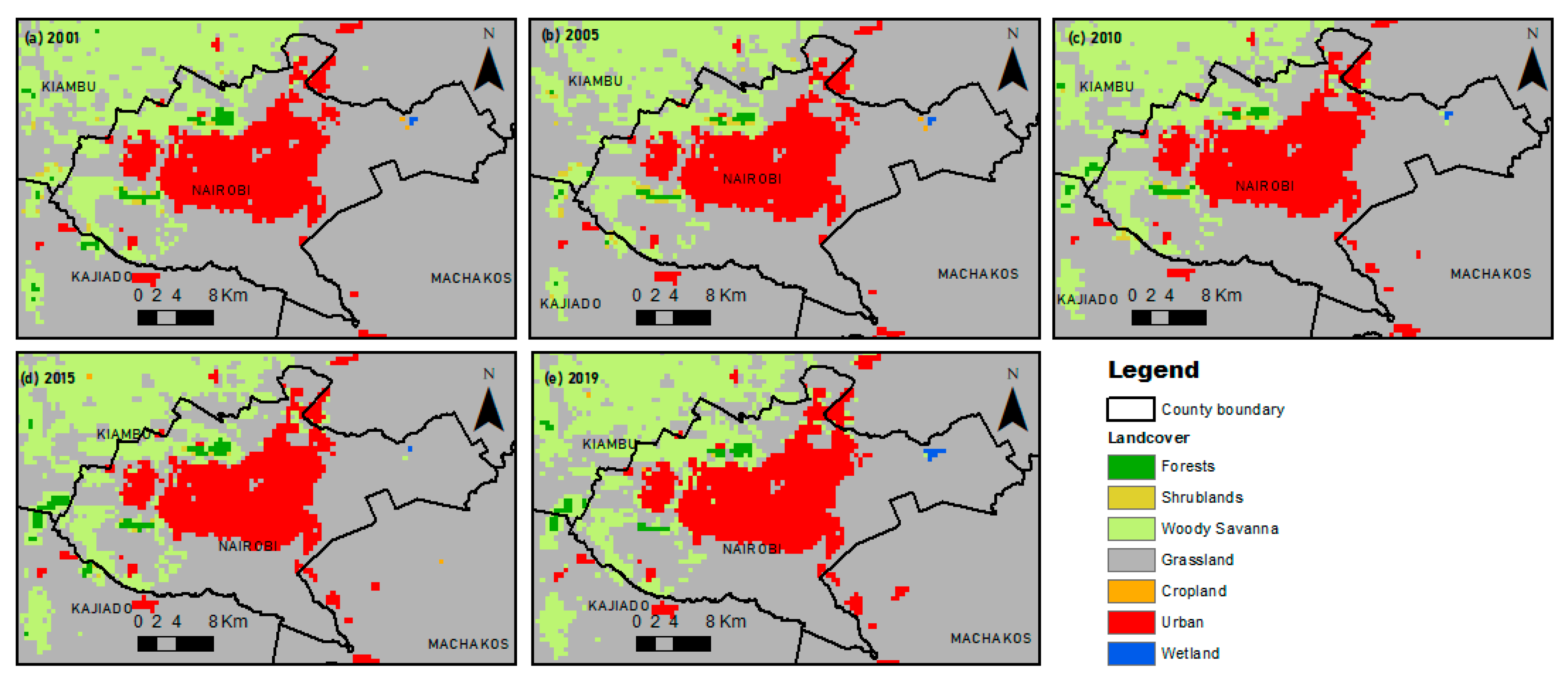
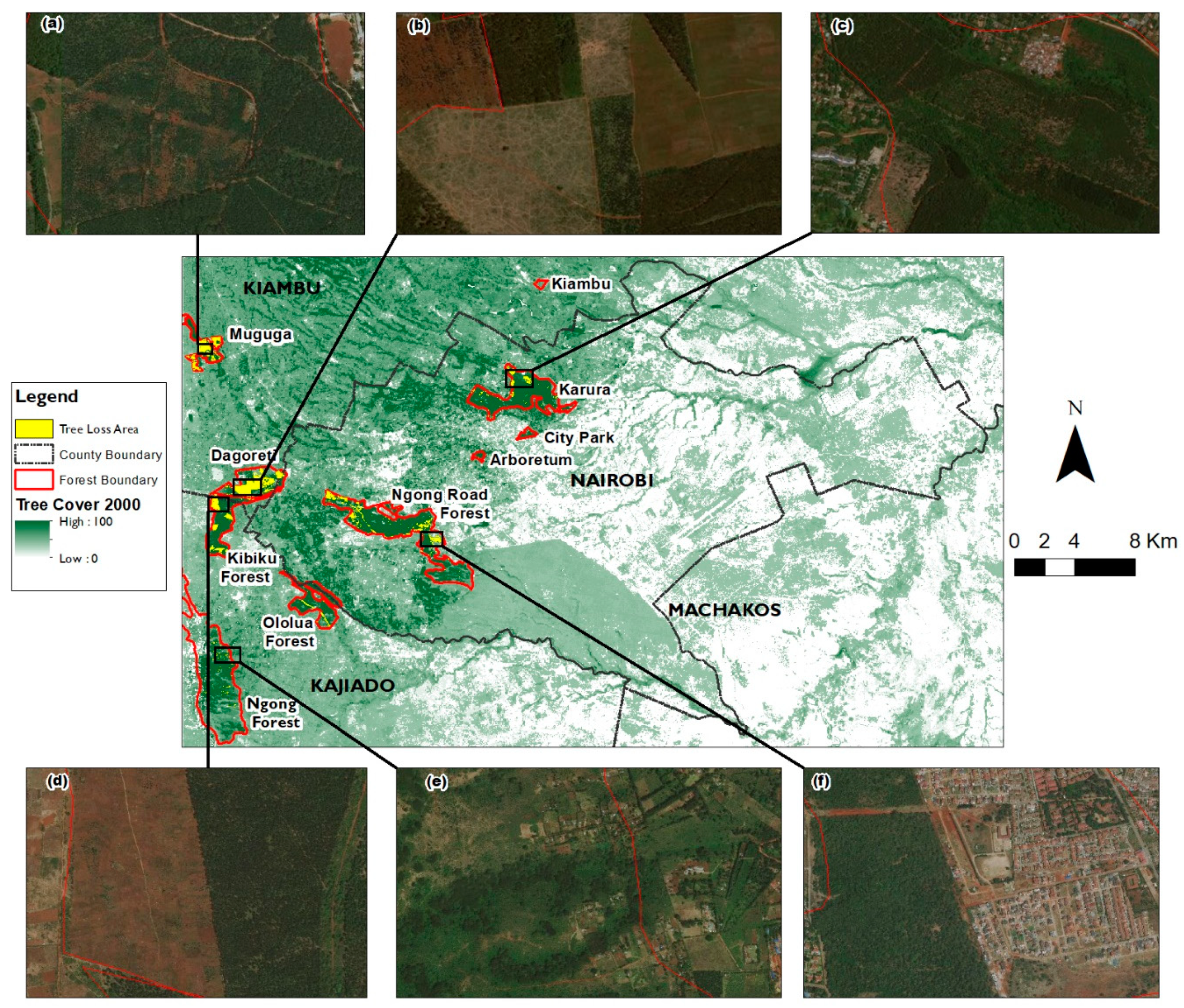
| Theme | Data Type | Resolution | Time | Source |
|---|---|---|---|---|
| Landsat 7 Collection 1 Tier 1 8-Day NDVI Composite | Raster/Imagery | 30 m | 2000–2019 | United States Geological Survey hosted in Google Earth Engine |
| Hansen Global Forest Change v1.7 (2000–2019) | Raster/Imagery | 30 m | 2001–2019 | Hansen hosted on Google Earth Engine |
| Global Forest Cover Change (GFCC) Tree Cover Multi-Year Global 30 m | Raster/Imagery | 30 m | 2000–2019 | NASA Land Processes Distributed Active Archive Center (LP DAAC) at USGS EROS Center |
| MODIS Land Cover Type Yearly Global 500 m | Raster/Imagery | 500 m | 2001–2019 | NASA Land Processes Distributed Active Archive Center (LP DAAC) at USGS EROS Center |
| Kenya Counties Shapefile | Shapefiles | 2015 | Open Africa https://africaopendata.org/dataset/kenya-counties-shapefile | |
| Protected Areas in Kenya | Shapefile | 2007 | Adapted from World Resource Institute https://datasets.wri.org/dataset/protected-areas-in-kenya | |
| World Imagery (Clarity) | Imagery | 2017 | Adopted from ArcMap 10.3 Desktop version |
| NDVI Change | 2001–2005 | 2001–2010 | 2001–2015 | 2001–2019 | ||||
|---|---|---|---|---|---|---|---|---|
| Pixels | % Percentage | Pixels | % Percentage | Pixels | % Percentage | Pixels | % Percentage | |
| Major decrease | 5411 | 7.1 | 3075 | 4 | 7203 | 9.5 | 14,886 | 19.6 |
| Mild decrease | 12,643 | 16.6 | 11,229 | 14.8 | 17,363 | 22.8 | 25,576 | 33.6 |
| Little change | 15,057 | 19.8 | 14,359 | 18.9 | 17,557 | 23.1 | 20,856 | 27.4 |
| Mild increase | 25,812 | 33.9 | 26,442 | 34.8 | 26,095 | 34.3 | 13,120 | 17.2 |
| Major increase | 17,143 | 22.5 | 20,961 | 27.6 | 7848 | 10.3 | 1628 | 2.1 |
| Total | 76,066 | 100 | 76,066 | 100 | 76,066 | 100 | 76,066 | 100 |
Publisher’s Note: MDPI stays neutral with regard to jurisdictional claims in published maps and institutional affiliations. |
© 2020 by the authors. Licensee MDPI, Basel, Switzerland. This article is an open access article distributed under the terms and conditions of the Creative Commons Attribution (CC BY) license (https://creativecommons.org/licenses/by/4.0/).
Share and Cite
Oloo, F.; Murithi, G.; Jepkosgei, C. Quantifying Tree Cover Loss in Urban Forests within Nairobi City Metropolitan Area from Earth Observation Data. Environ. Sci. Proc. 2021, 3, 78. https://doi.org/10.3390/IECF2020-07952
Oloo F, Murithi G, Jepkosgei C. Quantifying Tree Cover Loss in Urban Forests within Nairobi City Metropolitan Area from Earth Observation Data. Environmental Sciences Proceedings. 2021; 3(1):78. https://doi.org/10.3390/IECF2020-07952
Chicago/Turabian StyleOloo, Francis, Godwin Murithi, and Charlynne Jepkosgei. 2021. "Quantifying Tree Cover Loss in Urban Forests within Nairobi City Metropolitan Area from Earth Observation Data" Environmental Sciences Proceedings 3, no. 1: 78. https://doi.org/10.3390/IECF2020-07952
APA StyleOloo, F., Murithi, G., & Jepkosgei, C. (2021). Quantifying Tree Cover Loss in Urban Forests within Nairobi City Metropolitan Area from Earth Observation Data. Environmental Sciences Proceedings, 3(1), 78. https://doi.org/10.3390/IECF2020-07952






